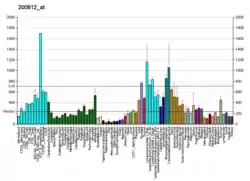CCT7
T-complex protein 1 subunit eta is a protein that in humans is encoded by the CCT7 gene.[5][6]
Function
This gene encodes a molecular chaperone that is a member of the TRiC complex. This complex consists of two identical stacked rings, each containing eight different proteins. Unfolded polypeptides enter the central cavity of the complex and are folded in an ATP-dependent manner. The complex folds various proteins, including actin and tubulin. Alternate transcriptional splice variants encoding different isoforms have been found for this gene, but only two of them have been characterized to date.[6]
References
- GRCh38: Ensembl release 89: ENSG00000135624 - Ensembl, May 2017
- GRCm38: Ensembl release 89: ENSMUSG00000030007 - Ensembl, May 2017
- "Human PubMed Reference:". National Center for Biotechnology Information, U.S. National Library of Medicine.
- "Mouse PubMed Reference:". National Center for Biotechnology Information, U.S. National Library of Medicine.
- Won KA, Schumacher RJ, Farr GW, Horwich AL, Reed SI (Dec 1998). "Maturation of human cyclin E requires the function of eukaryotic chaperonin CCT". Molecular and Cellular Biology. 18 (12): 7584–9. doi:10.1128/mcb.18.12.7584. PMC 109339. PMID 9819444.
- "Entrez Gene: CCT7 chaperonin containing TCP1, subunit 7 (eta)".
- Chen GI, Tisayakorn S, Jorgensen C, D'Ambrosio LM, Goudreault M, Gingras AC (Oct 2008). "PP4R4/KIAA1622 forms a novel stable cytosolic complex with phosphoprotein phosphatase 4". The Journal of Biological Chemistry. 283 (43): 29273–84. doi:10.1074/jbc.M803443200. PMC 2662017. PMID 18715871.
- Gingras AC, Caballero M, Zarske M, Sanchez A, Hazbun TR, Fields S, Sonenberg N, Hafen E, Raught B, Aebersold R (Nov 2005). "A novel, evolutionarily conserved protein phosphatase complex involved in cisplatin sensitivity". Molecular & Cellular Proteomics. 4 (11): 1725–40. doi:10.1074/mcp.M500231-MCP200. PMID 16085932.
External links
- Human CCT7 genome location and CCT7 gene details page in the UCSC Genome Browser.
Further reading
- Kubota H, Hynes G, Carne A, Ashworth A, Willison K (Feb 1994). "Identification of six Tcp-1-related genes encoding divergent subunits of the TCP-1-containing chaperonin". Current Biology. 4 (2): 89–99. doi:10.1016/S0960-9822(94)00024-2. PMID 7953530. S2CID 31300131.
- Maruyama K, Sugano S (Jan 1994). "Oligo-capping: a simple method to replace the cap structure of eukaryotic mRNAs with oligoribonucleotides". Gene. 138 (1–2): 171–4. doi:10.1016/0378-1119(94)90802-8. PMID 8125298.
- Hynes G, Celis JE, Lewis VA, Carne A, U S, Lauridsen JB, Willison KR (Nov 1996). "Analysis of chaperonin-containing TCP-1 subunits in the human keratinocyte two-dimensional protein database: further characterisation of antibodies to individual subunits". Electrophoresis. 17 (11): 1720–7. doi:10.1002/elps.1150171109. PMID 8982604. S2CID 11257092.
{{cite journal}}: CS1 maint: date and year (link) - Liou AK, Willison KR (Jul 1997). "Elucidation of the subunit orientation in CCT (chaperonin containing TCP1) from the subunit composition of CCT micro-complexes". The EMBO Journal. 16 (14): 4311–6. doi:10.1093/emboj/16.14.4311. PMC 1170057. PMID 9250675.
- Suzuki Y, Yoshitomo-Nakagawa K, Maruyama K, Suyama A, Sugano S (Oct 1997). "Construction and characterization of a full length-enriched and a 5'-end-enriched cDNA library". Gene. 200 (1–2): 149–56. doi:10.1016/S0378-1119(97)00411-3. PMID 9373149.
- Yokota S, Yanagi H, Yura T, Kubota H (Sep 2001). "Cytosolic chaperonin-containing t-complex polypeptide 1 changes the content of a particular subunit species concomitant with substrate binding and folding activities during the cell cycle". European Journal of Biochemistry. 268 (17): 4664–73. doi:10.1046/j.1432-1327.2001.02393.x. PMID 11532003.
- Suzuki H, Fukunishi Y, Kagawa I, Saito R, Oda H, Endo T, Kondo S, Bono H, Okazaki Y, Hayashizaki Y (Oct 2001). "Protein-protein interaction panel using mouse full-length cDNAs". Genome Research. 11 (10): 1758–65. doi:10.1101/gr.180101. PMC 311163. PMID 11591653.
- Imai Y, Soda M, Murakami T, Shoji M, Abe K, Takahashi R (Dec 2003). "A product of the human gene adjacent to parkin is a component of Lewy bodies and suppresses Pael receptor-induced cell death". The Journal of Biological Chemistry. 278 (51): 51901–10. doi:10.1074/jbc.M309655200. PMID 14532270.
{{cite journal}}: CS1 maint: date and year (link) - Hanafy KA, Martin E, Murad F (Nov 2004). "CCTeta, a novel soluble guanylyl cyclase-interacting protein". The Journal of Biological Chemistry. 279 (45): 46946–53. doi:10.1074/jbc.M404134200. PMID 15347653.
- Stelzl U, Worm U, Lalowski M, Haenig C, Brembeck FH, Goehler H, Stroedicke M, Zenkner M, Schoenherr A, Koeppen S, Timm J, Mintzlaff S, Abraham C, Bock N, Kietzmann S, Goedde A, Toksöz E, Droege A, Krobitsch S, Korn B, Birchmeier W, Lehrach H, Wanker EE (Sep 2005). "A human protein-protein interaction network: a resource for annotating the proteome". Cell. 122 (6): 957–68. doi:10.1016/j.cell.2005.08.029. hdl:11858/00-001M-0000-0010-8592-0. PMID 16169070. S2CID 8235923.
- Guo D, Han J, Adam BL, Colburn NH, Wang MH, Dong Z, Eizirik DL, She JX, Wang CY (Dec 2005). "Proteomic analysis of SUMO4 substrates in HEK293 cells under serum starvation-induced stress". Biochemical and Biophysical Research Communications. 337 (4): 1308–18. doi:10.1016/j.bbrc.2005.09.191. PMID 16236267.
This article is issued from Wikipedia. The text is licensed under Creative Commons - Attribution - Sharealike. Additional terms may apply for the media files.




